Fiber-Optic Bragg Gratings for Temperature and Pressure Measurements in Isotope Production Targets for Nuclear Medicine
Abstract
Featured Application
Abstract
1. Introduction
2. Materials and Methods
2.1. Fibers and Data Acquisition
- -
- λB is the Bragg wavelength of the FBG when datum strain and temperature is applied to the FBG,
- -
- ΔλB is the change in λB associated with a change in strain or temperature,
- -
- pe is the effective strain-optic constant,
- -
- Δε is the change in strain experienced over the length of the FBG
- -
- α is the coefficient of thermal expansion of the fiber (i.e.,)
- -
- ζ is the thermo-optic coefficient (i.e.,), and
- -
- ΔT is a change in temperature of the FBG.
2.1.1. Category 1: Ge-Doped Fiber (UV)
2.1.2. Category 2: Ge-Doped Fiber (FS)
2.1.3. Category 3: Pure Silica Fiber (RAD)
2.2. FBGs Response to Irradiation
2.3. Optical Gauge Amplifier
2.4. Proton Irradiation
2.5. Neutron Irradiation
2.6. Isotope Production Irradiation on a Medical Cyclotron
2.6.1. FBG-Based Temperature Probe and Pressure Transducer
2.6.2. Interpretation of Wavelength Shift
3. Results and Discussion
3.1. Proton and Neutron Irradiations
3.1.1. Radiation Induced Absorption
3.1.2. Radiation Induced Wavelength Shift
3.2. Comparison of FBG Categories
3.3. Isotope Production Irradiation
4. Conclusions
Author Contributions
Funding
Acknowledgments
Conflicts of Interest
References and Note
- Nuclear Energy Agency Medical Radioisotopes. 2017. Available online: https://www.oecdnea.org/med-radio/ (accessed on 10 May 2020).
- Robertson, A.; Lobbezoo, A.; Moskven, L.; Schaffer, P.; Hoehr, C. New target design to produce Ac-225 at TRIUMF. Instruments 2019, 3, 18. [Google Scholar] [CrossRef]
- Jahangiri, P.; Doering, R.; Ferguson, S.; Li, K.; Buckley, K.; Benard, F.; Martinez, D.M.; Hoehr, C. Modeling the pressure rise of a liquid target on a medical cyclotron: Steady-state analysis. Appl. Radiat. Isot. 2017, 120, 22. [Google Scholar] [CrossRef] [PubMed]
- Jahangiri, P.; Zacchia, N.; Buckley, K.; Benard, F.; Schaffer, P.; Martinez, D.M.; Hoehr, C. An analytical approach of thermodynamic behaviour in a gas target system on a medical cyclotron. Appl. Radiat. Isot. 2016, 107, 252. [Google Scholar] [CrossRef] [PubMed]
- Buckley, K.R.; Huser, J.; Jivan, S.; Chun, S.K.; Ruth, T.J. 11C-methane production in small volume, high pressure gas targets. Radiochim. Acta 2000, 88, 201–205. [Google Scholar] [CrossRef]
- Buckley, K.R.; Jivan, S.; Ruth, T.J. Improved yield for the in-situ production of [11C]CH4 using a niobium target chamber. Nucl. Med. Biol. 2004, 31, 825–827. [Google Scholar] [CrossRef] [PubMed]
- Stokely, M. Testing and Analysis of Advanced Thermosyphon Target Systems for Production of Aqueous [18F]Fluoride via 18O(p,n)18F. Ph.D. Thesis, North Carolina State University, Raleigh, NC, USA, 2008. [Google Scholar]
- Peeples, J.; Stokely, M.H.; Poorman, M.C.; Magerl, M.; Wieland, B.W. Visual observation of boiling in high power liquid target. AIP Conf. Proc. 2012, 1509, 76–80. [Google Scholar]
- Peeples, J.; Stokely, M.H.; Doster, J.M. Thermal performance of batch boiling water targets for 18F production. Appl. Radiat. Isot. 2011, 69, 1349–1354. [Google Scholar] [CrossRef] [PubMed]
- Alvord, C.W.; Ruggles, A.E.; West, C.D. Calculations of attainable superheats and predicted embryonic flux rates in commercial water isotope targets. Appl. Radiat. Isot. 2008, 66, 1781–1787. [Google Scholar] [CrossRef] [PubMed]
- Peeples, J.; Magerl, M.; O′Brien, E.; Doster, J.; Bolotnov, I.; Wieland, B.; Stokely, M. High current C-11 gas target design and optimization using multi-physics coupling. AIP Conf. Proc. 2017, 1845. [Google Scholar] [CrossRef]
- Faugl, T.; Stokely, M.; Wieland, B.; Bolotnov, I.; Doster, J.; Peeples, J.; Poorman, M. Modeling a water target with proton range and target density coupling. In Proceedings of the WTTC 15 Proceedings, Prague, Czech Republic, 18–24 August 2014. [Google Scholar]
- Hong, B.H.; Kang, J.; Jung, I.S.; Ram, H.G.; Park, Y.S.; Cho, H.H. Self-overcoming of the boiling condition by pressure increment in a water target irradiated by proton beam. Nucl. Instrum. Methods Phys. Res. A 2013, 728, 6–10. [Google Scholar] [CrossRef]
- Othonos, A. Fiber Bragg gratings. Rev. Sci. Instrum. 1997, 68, 4309–4341. [Google Scholar] [CrossRef]
- Hnatovsky, C.; Grobnic, D.; Mihailov, S.J. High-temperature stable π-phase-shifted fiber Bragg gratings inscribed using infrared femtosecond pulses and a phase mask. Opt. Express 2018, 26, 23550–23564. [Google Scholar] [CrossRef] [PubMed]
- Henschel, H.; Hoeffgen, S.K.; Krebber, K.; Kuhnhenn, J.; Weinand, U. Influence of fiber composition and grating fabrication on the radiation sensitivity of fiber Bragg grating. IEEE Trans. Nucl. Sci. 2008, 55, 2235–2242. [Google Scholar] [CrossRef]
- Mihailov, S.J.; Grobnic, D.; Hnatovsky, C.; Walker, R.B.; Lu, P.; Coulas, D.; Ding, H. Extreme environment sensing using femtosecond alser-inscribed fiber Bragg gratings. Sensors 2017, 17, 2909. [Google Scholar] [CrossRef] [PubMed]
- Morana, A. Gamma-Rays and Neutrons Effects on Optical Fibers and Bragg Gratings for Temperature Sensors, Optics/Photonic. Ph.D. Thesis, Université Jean Monnet–Saint Etienne, Saint-Étienne, France, 2013. NNT: 2013STET4023 (In English). [Google Scholar]
- Belanger-Champagne, C.; Blackmore, E.; Lindsay, C.; Hoehr, C.; Trinczek, M. Simulation and measurements of collimator effects in proton and neutron radiation testing for single event effects. IEEE Trans. Nucl. Sci. 2020, 67, 161. [Google Scholar] [CrossRef]
- Blackmore, E. Development of a Large Area Neutron Beam for System Testing at TRIUMF. In Radiation Effects Data Workshop; Stitute of Electrical and Electronics Engineers: Montreal, QC, Canada, 2009; pp. 157–160. [Google Scholar]
- Li, K.; Jahangiri, P.; Zacchia, N.; Uittenbosch, T.; Buckley, K.; Martinez, D.M.; Hoehr, C. Modular design for a liquid target. AIP Conf. Proc. 2017, 1845, 020013. [Google Scholar]
- Ziegler, J.; Ziegler, M.; Biersack, J. SRIM—The stopping and range of ions in matter (2010). Nucl. Instrum. Methods Phys. Res. B 2010, 268, 1818–1823. [Google Scholar] [CrossRef]
- For general information see www.fibos.ca.
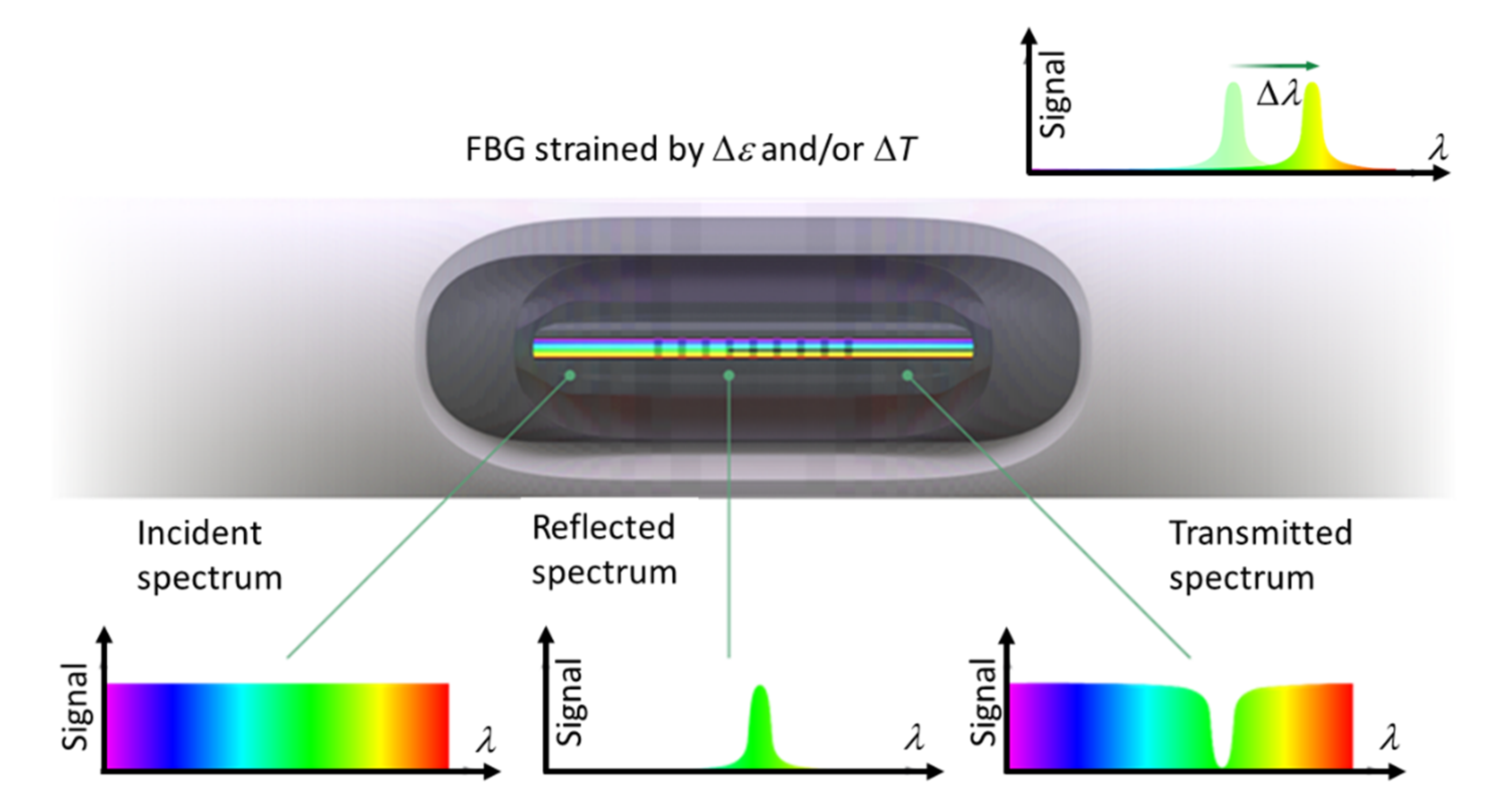
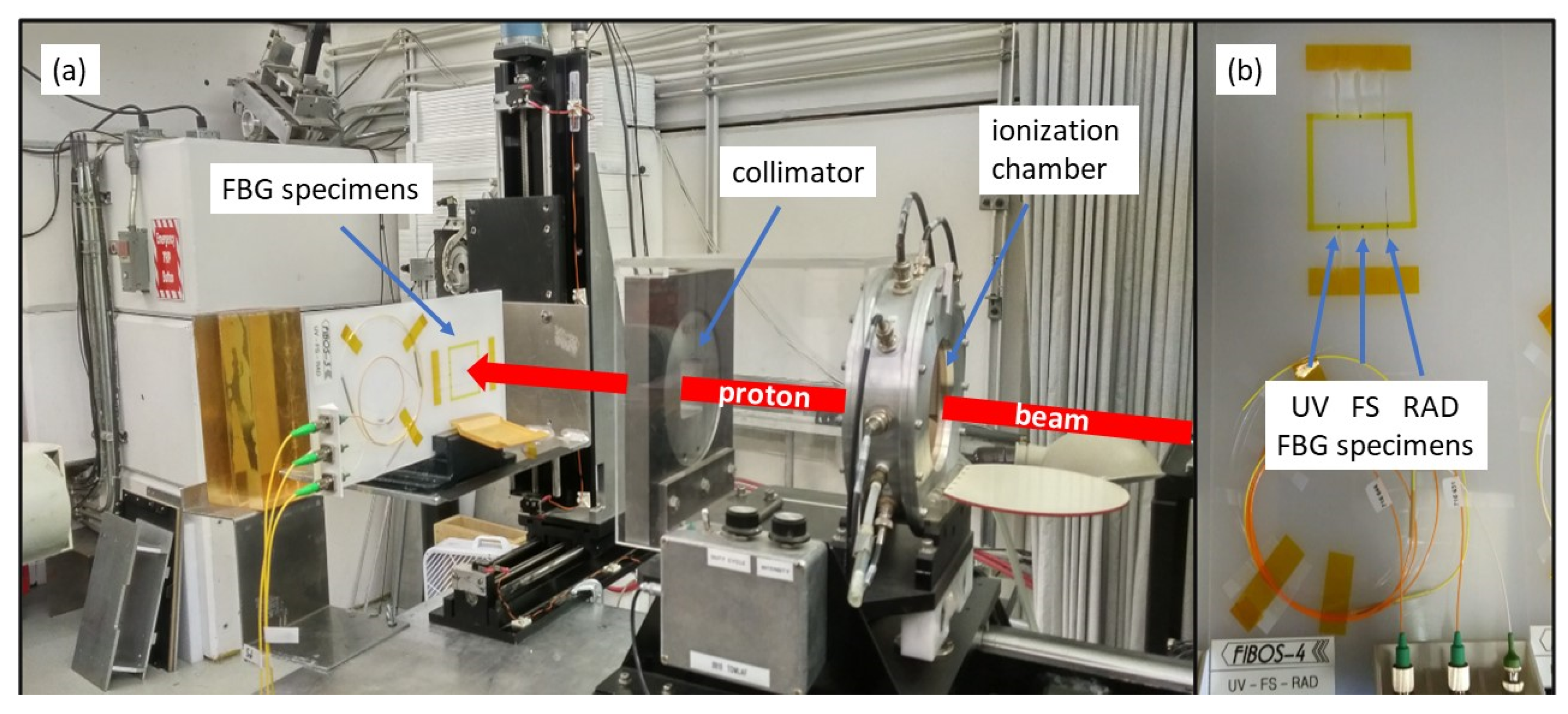
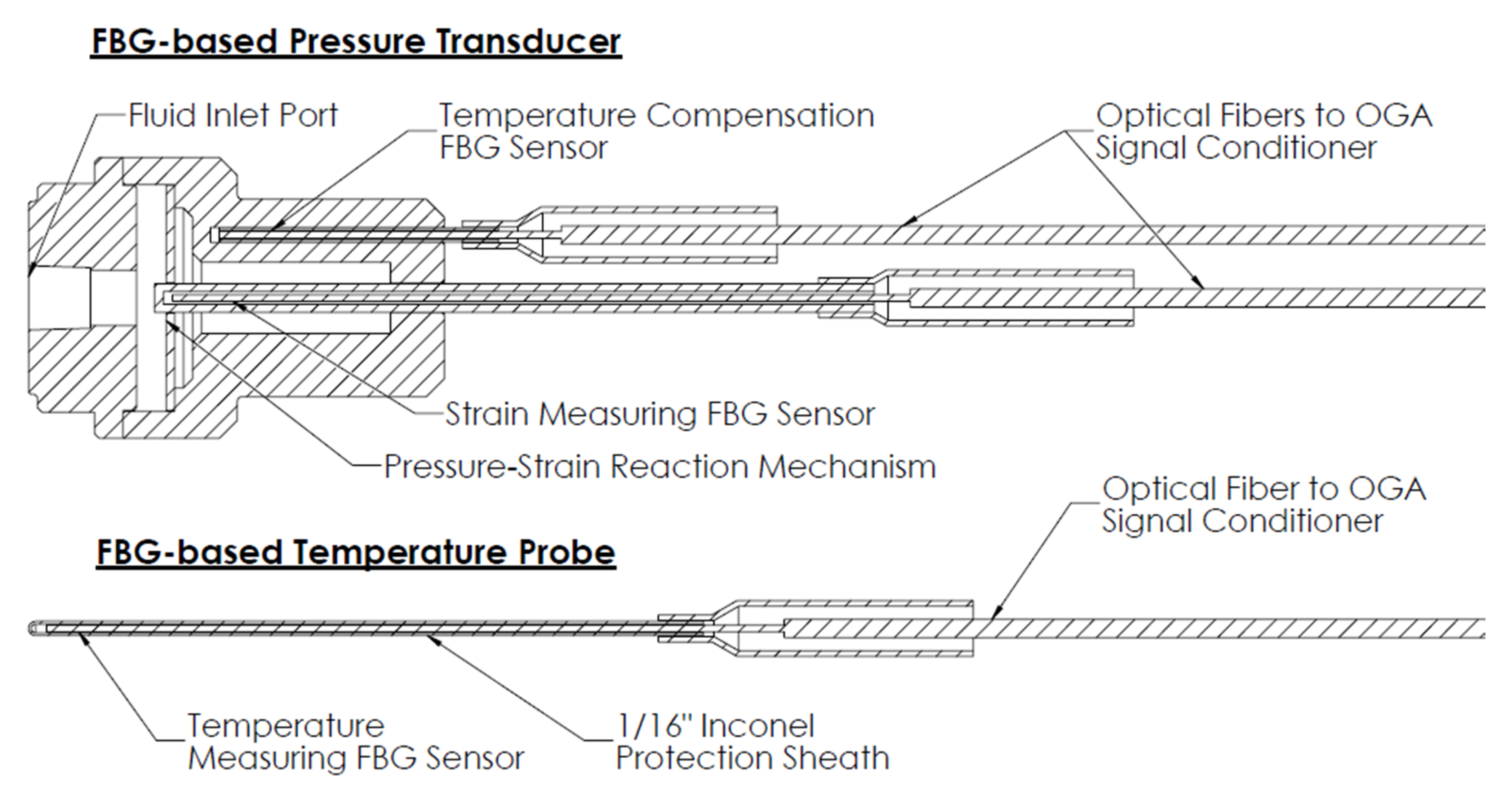
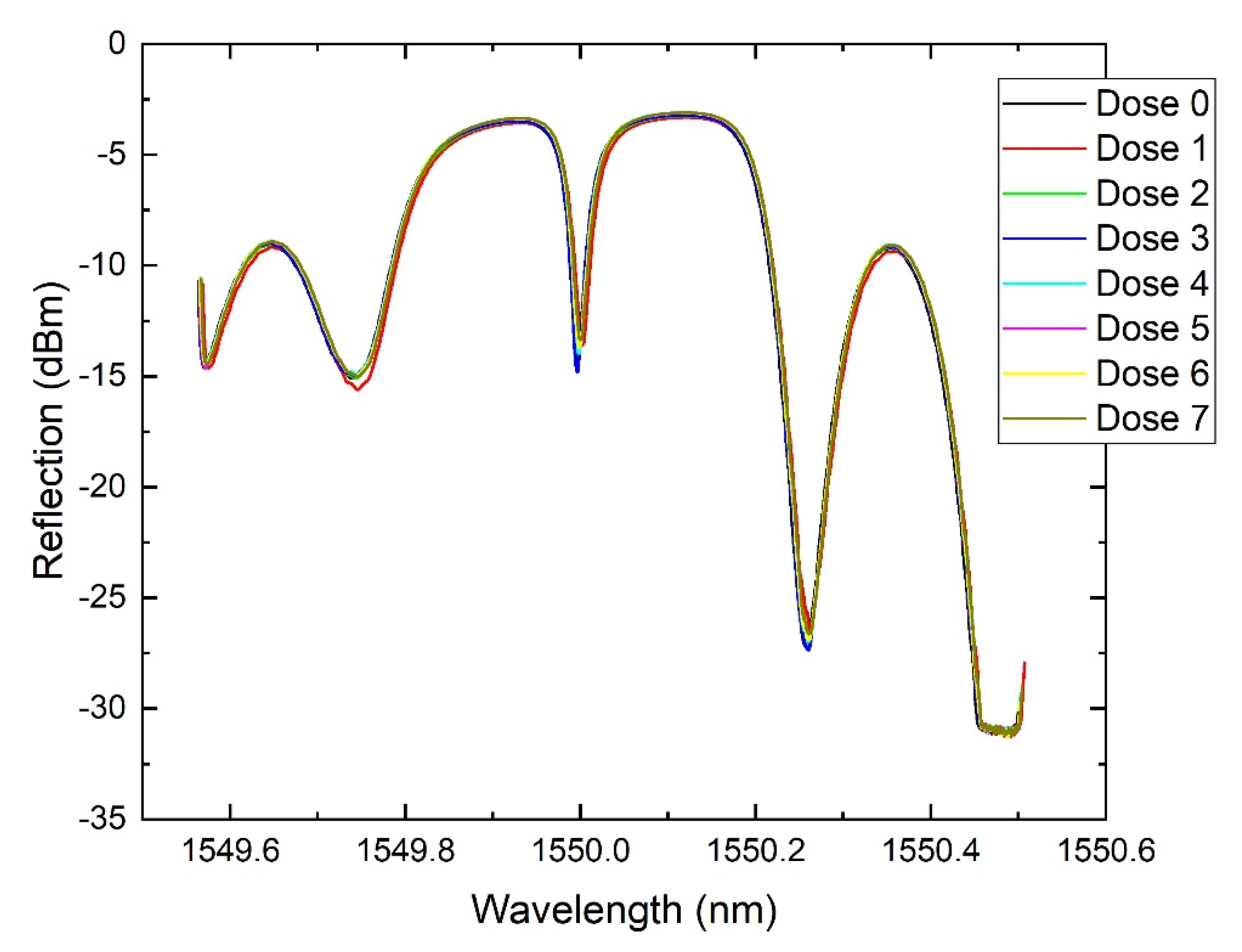
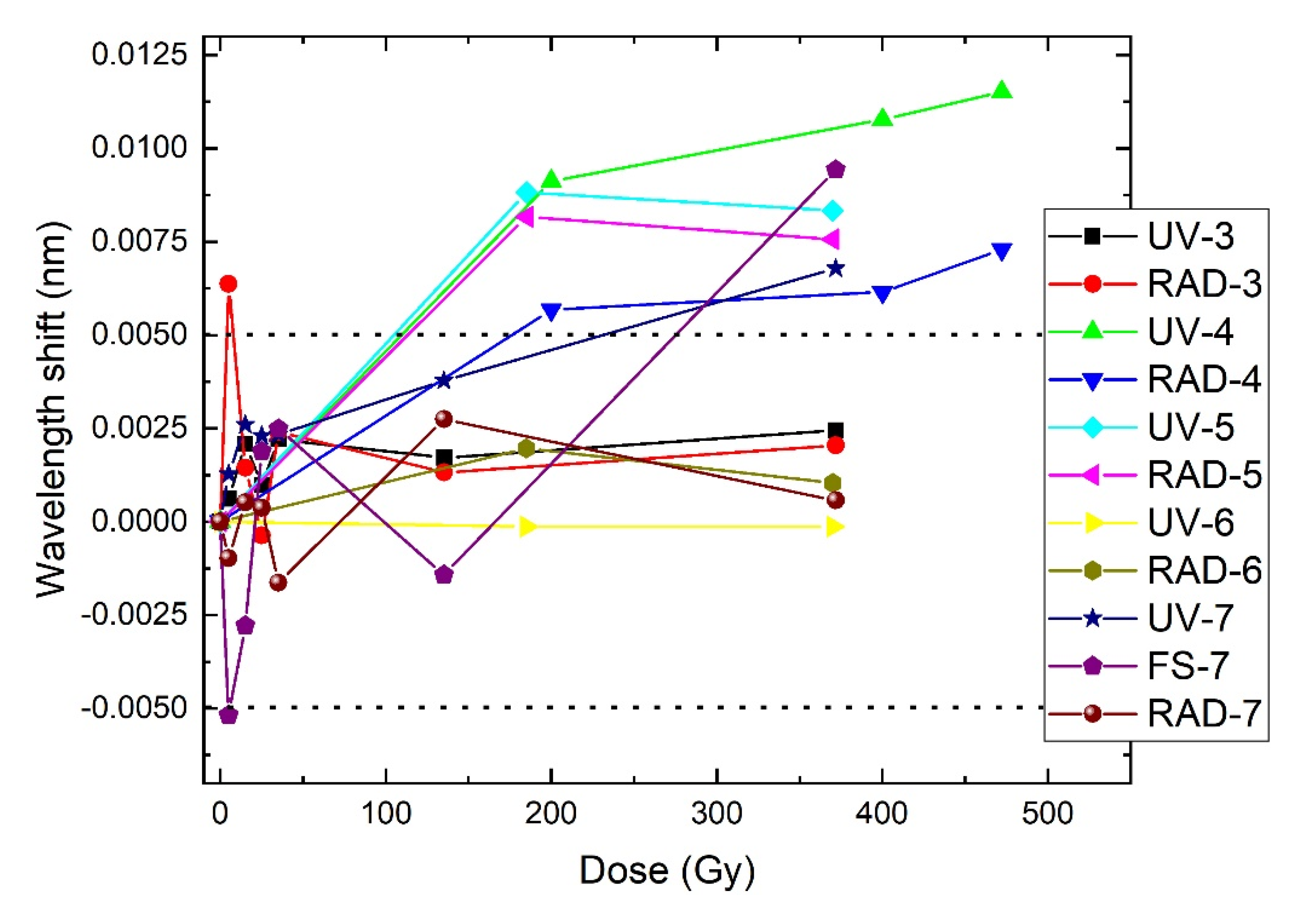


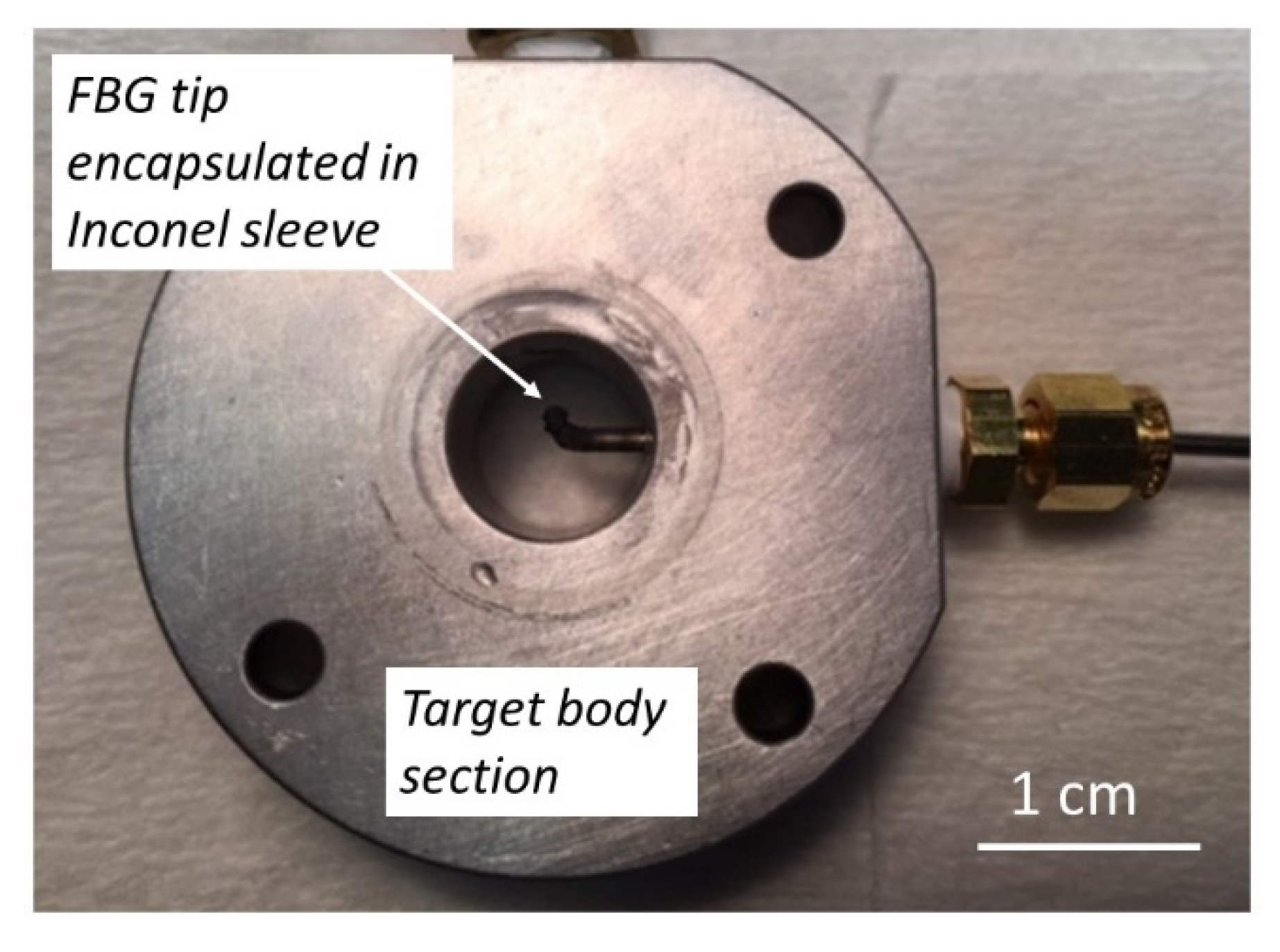
| Set | Radiation | Energy [MeV] | Dose Steps [Gy] | Flux [mGy/s] |
|---|---|---|---|---|
| 1 | None (control) | 0 | 0 | 0 |
| 2 | Neutrons | 0–400 | 1, 5, 10, 20, 35, 60 | fixed |
| 3 | Protons | 9 | 5, 10, 60 | 100, 500, 1000 |
| 4 | Protons | 13.5 | 5, 10, 60 | 100, 500, 1000 |
| 5 | Protons | 20 | 5, 10, 60 | 100, 500, 1000 |
| 6 | Protons | 35 | 5, 10, 60 | 100, 500, 1000 |
| 7 | Protons | 64 | 5, 10, 60 | 100, 500, 1000 |
© 2020 by the authors. Licensee MDPI, Basel, Switzerland. This article is an open access article distributed under the terms and conditions of the Creative Commons Attribution (CC BY) license (http://creativecommons.org/licenses/by/4.0/).
Share and Cite
Bakaic, M.; Hanna, M.; Hnatovsky, C.; Grobnic, D.; Mihailov, S.; Zeisler, S.S.; Hoehr, C. Fiber-Optic Bragg Gratings for Temperature and Pressure Measurements in Isotope Production Targets for Nuclear Medicine. Appl. Sci. 2020, 10, 4610. https://doi.org/10.3390/app10134610
Bakaic M, Hanna M, Hnatovsky C, Grobnic D, Mihailov S, Zeisler SS, Hoehr C. Fiber-Optic Bragg Gratings for Temperature and Pressure Measurements in Isotope Production Targets for Nuclear Medicine. Applied Sciences. 2020; 10(13):4610. https://doi.org/10.3390/app10134610
Chicago/Turabian StyleBakaic, Michael, Matthew Hanna, Cyril Hnatovsky, Dan Grobnic, Stephen Mihailov, S. Stefan Zeisler, and Cornelia Hoehr. 2020. "Fiber-Optic Bragg Gratings for Temperature and Pressure Measurements in Isotope Production Targets for Nuclear Medicine" Applied Sciences 10, no. 13: 4610. https://doi.org/10.3390/app10134610
APA StyleBakaic, M., Hanna, M., Hnatovsky, C., Grobnic, D., Mihailov, S., Zeisler, S. S., & Hoehr, C. (2020). Fiber-Optic Bragg Gratings for Temperature and Pressure Measurements in Isotope Production Targets for Nuclear Medicine. Applied Sciences, 10(13), 4610. https://doi.org/10.3390/app10134610





